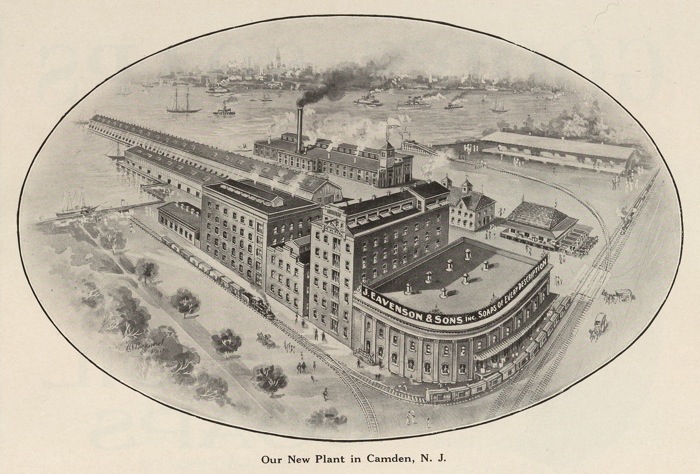
J. Eavenson & Sons, Inc., Camden, NJ. © Philadelphia Year Book, 1917, p. C 47.
Wool Scouring at Eavenson & Levering, Camden, NJ.
© Don Kraft, The Wright Stuff, Oliver Evans Chapter Newsletter (January 1991), p. 1 & 3.
Paul Schopp kicked off our fall [1990] series of events with an encore presentation of his conference paper on Eavenson and Levering, an 1895-1951 wool scouring firm located in Camden, New Jersey. Paul's research came about as a result of an environmental contamination report that was being prepared prior to proposed reuse of the now partially used buildings. In general, the mechanization of wool processing lagged behind that of cotton, and in the 18th century, wool was softened and napped using animal urine, and cleaned using soap. The onset of the Civil War simultaneously increased the demand for fabrics (uniforms, blankets, etc.) and cut off a large share of the cotton shipped to the north. Thus, cotton mills converted to wool during the war, and more advancements in wool processing mechanization began to be developed. This was expressed locally with the founding of the Camden Woolen Mill (1865), and by 1890, Camden found itself second in the country in woolen goods.
It was under these circumstances that Alban Eavenson began his new career. He had been a Philadelphia soap manufacturer in the late 1890s, and in 1900 he applied that experience to the thriving Camden woolens market by starting a firm that dealt with wool and wool waste. He soon joined forces with Mr. Levering, and the business began to expand. In 1909, they moved to their Newton Creek site, and in 1913 their Building 13 tripled mill capacity. In 1912 the company employed 350 workers, and in 1918, 500. By 1927 they had become the largest wool scouring plant in the world. Even during the depression era, they remained strong and healthy, with 4,365 male and 50 female workers.
Their post World War II force of 500 workers marked the company's zenith, but also the beginning of its decline. In the 1940s, the firm was bought out by a competitor, and without the "family" atmosphere of the original owners, perhaps the stage had been set for future discontent. In 1947, a crippling strike shut down the firm for several months, and it never quite seemed to recover. Although records show that new equipment was being installed at the plant right up to the end, manufacturing ceased in 1951. Several of the buildings are now used as warehouse space.
The scouring process began with raw wool shipments by boxcar or boat, then horse and wagon delivered the thousands of bales of wool to the E & L warehouses each week. The preprocessed wool was described as "in the grease," since it was contaminated with dirt, vegetable matter, dung, dander, and lanolin (grease). The purpose of processing was to remove these contaminants and clean and sort the fibers according to the wishes of the client. The overall process reduced 100 lbs of wool "in the grease" to 30-35 lbs of final wool product.
Upon arrival, the wool was weighed, then sorted as to length, elasticity, rmeness, and color of fiber. Opener, wihower, and pickerer machines opened the fibers and removed some vegetable matter. In the scouring miU, the dung and dander were washed away, and the lanolin was extracted (first extracted as a non-waste material in the 1920s).
If the client requested it, the wool went to the carbonizing mill in Building 20, where it was bathed in an acid solution, then sent through steam ovens that burned the burrs and remaining vegetable matter. Following this, rollers crushed the burnt matter, and willowers and dusters removed it.
Scoured, but uncarbonized wool was steam dried and reduced to a 12% moisture content, and, through the 1920s, was carded and combed as well. Thereafter it was merely baled for storage or shipping. Thanks to Paul for his fascinating talk.
[Note: the carbonizing building, erected about 1913, went up in flames from a fire of suspicious origin on the night of November 10, 1990. It has now been fairly well leveled.]